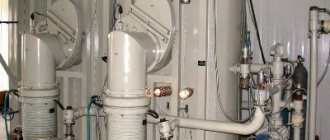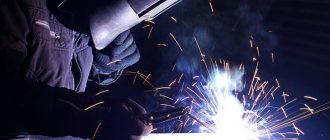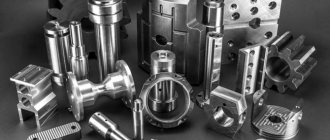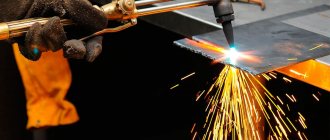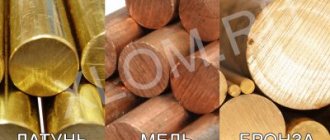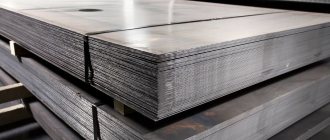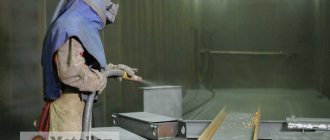Degree of cold hardening
Cold hardening is used to increase the strength properties of aluminum and aluminum alloys that are not strengthened by heat treatment. Sometimes these alloys - mainly alloys of the 3xxx and 5xxx series - are called in a positive way: strain-hardening. The main “levers” for obtaining one or another cold-worked state are the degree of cold-working - the amount of plastic cold deformation and annealing, full or partial - heating to a temperature of 350-400 ° C for a duration usually sufficient for complete heating.
What is metal hardening?
Unlike cold hardening, cold hardening is a more capacious concept. The hardening process can have both positive and negative effects. This is any manifestation of strain hardening of crystalline materials - beneficial and harmful, intentional or unintentional. If undesirable harmful hardening occurs, for example, when cutting ductile soft metals and alloys, then parts made of these materials are subject to further heat treatment. As a result of recrystallization, under the influence of high temperature, the undeformed grain structure is restored. Useful hardening is created specifically under the influence of cold plastic deformation. In this case, both terms are appropriate: cold hardening and hardening.
Designation of states of aluminum alloys
To designate all states of aluminum and aluminum alloys (and not only cold-worked ones), the American designation system, developed at one time by the American Aluminum Association, is widely used throughout the world.
- The original designation system for the states of wrought aluminum alloys is set out in the American standard ANSI H35.1.
- This system is almost “one to one” adopted by the international standard ISO 2107 and the European standard B 515.
- Domestic standards (GOST) still use their own system of designating states, which differs significantly from the international one.
The state of the material in a hot-pressed state without additional treatments - thermal or deformation - is indicated in B and ISO standards by the letter F and no numbers follow it. In domestic standards, this state is not designated at all.
The state of fully annealed material is indicated by the letter
“O” (not zero) according to the international classification of states of aluminum and aluminum alloys or “M” - according to domestic GOSTs. The letter O with an additional number refers to annealing with special conditions.
All designations of cold-worked states begin with the Latin letter “H”. It can be followed by 1 to 3 digits.
Types of hardening
Strain hardening of metal is classified according to the processes that are activated in the workpiece during the formation of the work-hardened layer.
In the case of the formation of new phases that differ in a different specific volume, the phenomenon is called phase. If the cause of the changes is the action of external forces, hardening is called deformation hardening.
There are two categories:
- Centrifugal ball. The product is affected by balls that are located in the rim sockets of the installation. Its operating principle is based on rotation, when, under the influence of centrifugal force, the elements exert a mechanical effect on the workpiece being processed.
- Shot blaster. This method is based on the use of kinetic energy. Shots with a diameter of up to 4 mm, made of durable material: cast iron, steel or ceramics, are used as processing elements. According to technological requirements, the flow speed can reach 70 m/s.
Let us consider the characteristic changes in the material that occur during strain hardening. As a result of the action of external forces, the elements of the internal structure begin to actively move, which leads to distortion inside the crystal lattice. In this case, the grains, the orientation of which is random, acquire a clear structure - the strongest axis of the crystals will be located along the direction of deformation.
While studying the phenomenon, some experts expressed the opinion that under the influence of external forces, the metal grains are crushed, and this leads to a refinement of the structure. In fact, they are only deformed, maintaining the same volume.
Hardening only – H1 series
Purely cold-worked states without additional treatments form the H1 series. The fully cold-worked state of the material, which is designated H18, is the state obtained by cold deformation equivalent to a relative rolling reduction of 0.75. Relative reduction is the ratio of the difference between the thicknesses of the initial and final sheets to the original thickness of the sheet. A relative elongation of 0.75 will be achieved, for example, with an initial thickness of 10 mm and a final thickness of 2.5 mm: (10 – 2.5)/10 = 0.75. Condition H19 denotes products with an even greater degree of hardening than in condition H18. It is used, for example, for 0.30mm thick 3104 aluminum alloy strip to make a beer can body. States H16, H14 and H12 are obtained with less cold deformation and they represent, respectively, three-quarter hardened
,
semi-hardened
and
quarter-hardened
states.
Where are cold-worked products used?
Metal parts with strain hardening have excellent performance characteristics. They are indispensable in structures that are subject to significant mechanical loads, adverse effects (sudden temperature changes, pressure fluctuations, etc.) Cold-worked steel is used in various industries: mechanical engineering, construction, shipbuilding, the automotive industry, etc. Cold-worked aluminum sheets (AMtsN) and (AMtsN2) are used for ship cladding, in the creation of building structures, in food production, and in the automotive industry for the manufacture of radiators, frames, and rivets. Today, thanks to its strength properties and the ability to significantly increase the efficiency of metalworking, cold hardening has a wide range of applications. Hardening of metal is an effective way to strengthen it.
Aluminum states H111 and H112
When specifying the requirements for the mechanical properties of aluminum and aluminum alloys, the designations of states H111 and H112 from the same H1 series are often used. The H111 state differs from the annealed O state only by the small degree of hardening that the material could receive during straightening or other technological operations. Condition H112 differs from condition F only in a small degree of hardening (during hot or cold working), as well as mandatory control of mechanical properties.
Mechanical properties
During the cold hardening process:
- The hardness of the metal product increases;
- Increases resistance to mechanical stress;
- Resistance to dynamic loads and resistance to plastic deformations with the opposite sign decreases (Bauschinger effect);
- Indicators of plasticity, such as relative residual elongation and narrowing, are lost.
Due to this, the yield strength of the metal is reduced - the maximum stress on the product at which it begins to deform plastically. If the degree of load does not exceed the permissible limit, then the metal returns to its original state after the influence of external forces ceases. Stress above the ductility limit is unacceptable for cold-worked steel, which is used in the construction of load-bearing structures of various buildings and structures.
Hardening and annealing - series H2
The H2 series refers to materials that have been cold-worked to a higher degree than would be necessary for the given strength properties, and then reduce this “extra” strength and remove it using partial annealing. With an increase in the degree of hardening, the second digit increases from 2 to 8, similar to the purely cold-hardened states: H22, H24, H26 and H28.
The figure schematically shows the cold-worked states of the H1 and H2 series at different degrees of cold-working and different annealing durations at a constant temperature. There are similar graphs depending on the annealing temperature. States with the same second digits have the same strength limits, and the yield strength of states with partial annealing is lower than that of purely cold-worked states. The graph of strength growth versus the degree of cold deformation has an upward convexity. This reflects the fact that the first stages of cold deformation give the maximum increase in strength.
Aluminum cold hardening - Metals, equipment, instructions
Aluminum is a ductile and lightweight white metal coated with a silver matte oxide film. In the periodic system of D.I. Mendeleev, this chemical element is designated as Al (Aluminium) and is located in the main subgroup of group III, third period, under atomic number 13. You can buy aluminum on our website.
History of discovery
In the 16th century, the famous Paracelsus took the first step towards aluminum mining. From alum, he isolated “alum earth,” which contained the oxide of a then unknown metal. In the 18th century, the German chemist Andreas Marggraff returned to this experiment.
He named the aluminum oxide “alumina,” which means “astringent” in Latin. At that time, the metal was not popular because it was not found in its pure form. For many years, English, Danish and German scientists tried to isolate pure aluminum.
In 1855, at the Paris World Exhibition, the metal aluminum created a sensation. Only luxury items and jewelry were made from it, since the metal was quite expensive. At the end of the 19th century, a more modern and cheaper method of producing aluminum appeared.
In 1911, the first batch of duralumin, named after the city, was produced in Duren. In 1919, the first airplane was created from this material.
Physical properties
Aluminum metal is characterized by high electrical conductivity, thermal conductivity, resistance to corrosion and frost, and ductility. It lends itself well to stamping, forging, drawing, and rolling. Aluminum can be welded well with various types of welding.
An important property is its low density of about 2.7 g/cm³. The melting point is about 660°C. The mechanical, physicochemical and technological properties of aluminum depend on the presence and amount of impurities that worsen the properties of the pure metal.
The main natural impurities are silicon, iron, zinc, titanium and copper.
According to the degree of purification, aluminum is distinguished between high and technical purity. The practical difference is the difference in corrosion resistance to certain environments. The purer the metal, the more expensive it is. Technical aluminum is used for the production of alloys, rolled products and cable and wire products.
High purity metal is used for special purposes. In terms of electrical conductivity, aluminum is second only to gold, silver and copper. And the combination of low density and high electrical conductivity allows it to compete with copper in the field of cable and wire products.
Long-term annealing improves electrical conductivity, while cold hardening worsens it.
The thermal conductivity of aluminum increases with increasing purity of the metal. Impurities of manganese, magnesium and copper reduce this property. In terms of thermal conductivity, aluminum is inferior only to copper and silver.
Due to this property, the metal is used in heat exchangers and cooling radiators. Aluminum has a high specific heat capacity and heat of fusion. These figures are significantly higher than those of most metals.
The higher the purity of aluminum, the more it is able to reflect light from the surface. The metal is well polished and anodized.
Aluminum has a high affinity for oxygen and is covered in air with a thin, durable film of aluminum oxide.
This film protects the metal from subsequent oxidation and provides its good anti-corrosion properties.
Aluminum is resistant to atmospheric corrosion, sea and fresh water, and practically does not interact with organic acids, concentrated or diluted nitric acid.
Chemical properties
Aluminum is a fairly active amphoteric metal. Under normal conditions, a strong oxide film determines its durability. If the oxide film is destroyed, aluminum acts as an active reducing metal.
In a finely crushed state and at high temperatures, the metal interacts with oxygen. When heated, reactions occur with sulfur, phosphorus, nitrogen, carbon, and iodine. Under normal conditions, the metal reacts with chlorine and bromine. There is no reaction with hydrogen.
With metals, aluminum forms alloys containing intermetallic compounds - aluminides.
Provided that the oxide film is removed, vigorous interaction with water occurs. Reactions with dilute acids occur easily. Reactions with concentrated nitric and sulfuric acid occur when heated. Aluminum reacts easily with alkalis. Practical application in metallurgy has found the property of reducing metals from oxides and salts - aluminothermy reactions.
Receipt
Aluminum is in first place among metals and in third place among all elements in terms of abundance in the earth's crust. Approximately 8% of the mass of the earth's crust is this metal.
Aluminum is found in the tissues of animals and plants as a trace element. In nature, it is found bound in the form of rocks and minerals.
The rocky shell of the earth, which is at the base of the continents, is formed precisely by aluminosilicates and silicates.
During the destruction of aluminosilicates of primary origin (feldspars), various secondary rocks with a higher aluminum content (alunites, kaolins, bauxites, nephelines) were formed. Aluminum is included in secondary rocks in the form of hydroxides or hydrosilicates.
However, not every aluminum-containing rock can be a raw material for alumina, a product from which aluminum is produced using the electrolysis method.
Aluminum is most often obtained from bauxite. Deposits of this mineral are common in countries of the tropical and subtropical zone. In Russia, nepheline ores are also used, deposits of which are located in the Kemerovo region and on the Kola Peninsula. When extracting aluminum from nephelines, potash, soda ash, cement and fertilizers are also produced along the way.
Bauxite contains 40-60% alumina. It also contains iron oxide, titanium dioxide, and silica. The Bayer process is used to isolate pure alumina.
In an autoclave, the ore is heated with caustic soda, cooled, and the “red mud” (solid sediment) is separated from the liquid. Afterwards, aluminum hydroxide is precipitated from the resulting solution and calcined to obtain pure alumina.
Alumina must meet high standards for purity and particle size.
Alumina (aluminum oxide) is extracted from the mined and enriched ore. The alumina is then converted into aluminum using electrolysis. The final stage is recovery by the Hall-Heroux process. The process is as follows: during the electrolysis of an alumina solution in molten cryolite, aluminum is released.
The cathode is the bottom of the electrolysis bath, and the anode is carbon bars located in cryolite. Molten aluminum is deposited under a solution of cryolite with 3-5% alumina. The process temperature rises to 950°C, which is much higher than the melting point of aluminum itself (660°C).
Deep purification of aluminum is carried out by zone melting or distillation through subfluoride.
Application
Aluminum is used in metallurgy as a base for alloys (duralumin, silumin) and an alloying element (alloys based on copper, iron, magnesium, nickel).
Aluminum alloys are used in everyday life, in architecture and construction, in shipbuilding and automotive industry, as well as in space and aviation technology. Aluminum is used in the production of explosives.
Anodized aluminum (coated with colored films of aluminum oxide) is used to make jewelry. Metal is also used in electrical engineering.
Let's look at how various aluminum products are used
Aluminum tape is a thin aluminum strip 0.3-2 mm thick, 50-1250 mm wide, which is supplied in rolls. The tape is used in the food, light, and refrigeration industries for the manufacture of cooling elements and radiators.
Round aluminum wire is used for the manufacture of cables and wires for electrical purposes, and rectangular for winding wires.
Aluminum pipes are durable and resistant in rural and urban industrial areas. They are used in finishing works, road construction, construction of cars, aircraft and ships, production of radiators, pipelines and gas tanks, installation of heating systems, main pipelines, gas pipelines, water pipelines.
Aluminum bushings are characterized by ease of processing, installation and operation. They are used for the end connection of metal cables.
An aluminum circle is a solid round section profile. This product is used for the manufacture of various designs.
Aluminum rod is used to make nuts, bolts, shafts, fasteners and spindles. About 3 mg of aluminum enters the human body through food every day.
The most metal is found in oatmeal, peas, wheat, and rice.
Scientists have found that it promotes regeneration processes, stimulates the development and growth of tissues, and affects the activity of the digestive glands and enzymes.
Series H3 – for aluminum-magnesium alloys
Series N3 – states with cold hardening and stabilizing treatment: N32, N34, N36 and N38. This series of states is used only for aluminum-magnesium alloys - alloys of the 5xxx series. The fact is that in a cold-worked state, these alloys can lose the strength properties achieved by cold-working for some time due to the mechanism of natural aging. Therefore, if stability of strength properties is important, they are often heated to moderate temperatures, such as 220°C, to complete this aging process, thereby reducing strength somewhat but increasing ductility and thereby ensuring subsequent stability of mechanical properties and performance.
Dislocations in aluminum
When casting aluminum ingots, the primary crystals grow from the liquid phase and the cast microstructure is usually very coarse. When aluminum is plastically deformed, each grain is deformed by the movement of linear defects in its crystal lattice. Deformation occurs due to slippage
along
slip planes
along shear directions.
These defects are called dislocations
(Figure 1). Dislocations move along certain crystallographic planes in the crystal - so-called "closely packed planes", which are known as slip planes. The movement of a single dislocation produces a single shear strain, while the combined movement of hundreds of thousands of dislocations produces a complete strain.
During deformation at room temperature, the number of dislocations increases and it becomes difficult for them to move through the atomic lattice. In this case, they say that the aluminum has “been cold-worked,” “strain-hardened,” or even “work-hardened,” and such aluminum or an aluminum alloy is called cold-worked. This means that more and more effort is required to continue deformation, and aluminum gradually loses its ductility, which will ultimately lead to the formation of cracks in it and its destruction.
At this time, the following happens at the atomic level. During deformation, dislocation glide occurs very actively and moving dislocations of different slip planes begin to interact with each other, become entangled with each other and form a so-called “forest” of dislocations. As the dislocation density increases, the yield strength of the material increases—somewhere directly proportional to the square root of the dislocation density.
Softening
A process in which there is a reduction in the stress required for plastic flow of a material. As a rule, this phenomenon can be observed in hardened steels during high-temperature tempering.
Thermal softening parameters depend on the degree of hardening. The negative consequences of this phenomenon must be taken into account in any operations with metal products. For example, car body parts are made by stamping and joined using spot welding, the use of which is local. When performing body repairs, it is necessary to use equipment that has the smallest heat-affected zone. Otherwise, heating above the recrystallization temperature will lead to softening of the element.
Why is aluminum ductile?
The ability to undergo large plastic deformations is one of the most useful properties of metals. Metals with a face-centered cubic lattice, which includes aluminum, usually exhibit good ductility - they can be easily deformed into various complex shapes. Typically metals are made up of large numbers of individual grains or crystals, meaning they are polycrystalline. A typical grain or crystal of aluminum after hot and cold working and then annealing has a diameter of, say, 40 microns, and the unit cell of the atomic crystal lattice is only about 0.4 nm = 0.0004 microns. So each grain contains many millions of such elementary cells - about 10 15 pieces.
Equipment used
The procedure for surface strain hardening is used in various industries that place increased demands on surface resistance to cracking.
There is a wide selection of metal hardening equipment. Dimensions and technical characteristics depend on the size of the processed products and production volumes.
Useful hardening on an industrial scale is performed on machines with a high level of automation. Shot blasting machines are mainly used.
Temperature tempering of the metal is used to remove cold hardening. This helps to activate processes that return the material to its original state.
Metal hardening is a process that, along with cold hardening, is actively used in the manufacture of components and assemblies in various industries. Have you encountered strain hardening of a surface? Do you think the cold hardening process will be in demand in the foreseeable future? Write your opinion in the comments block.
Re-hardening
This is a phenomenon characterized by the destruction of the crystal lattice of a material.
The process is accompanied by peeling and peeling of metal particles, which reduces the performance of the surface. Usually, overhardening occurs when the technological requirements of mechanical processing of products are violated. The reason is excess pressure in the contact area between the tool and the workpiece.
This process is irreversible: the properties of the metal cannot be restored even with the help of heat treatment.
